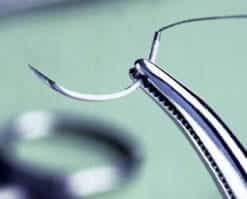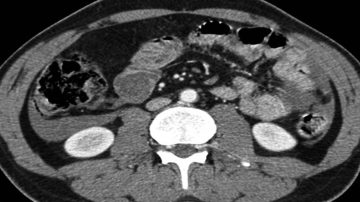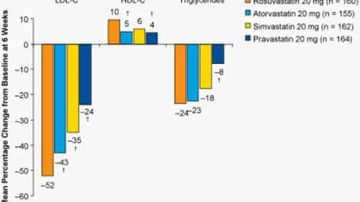The USPSTF continues to recommend screening primarily in 65- to 75-year-old men who have ever smoked. U.S. Preventive Services Task Force (USPSTF) Background Prevalence of abdominal aortic aneurysms (AAAs; defined by an aortic diameter of ≥3.0 cm) in adults older…
Read MoreIn a randomized trial, absorbable sutures achieved cosmetic results and complication rates similar to those of nonabsorbable sutures in both children and adults. Absorbable sutures have been demonstrated to be safe and effective for repair of facial lacerations (NEJM JW…
Read MorePatients with minimal free fluid and no abdominal tenderness can be observed, while patients with moderate-large amounts of free fluid and abdominal tenderness should undergo operative exploration. To determine if operative exploration or observation is the preferred management for hemodynamically…
Read MoreTuition Price Just Reduced for the Premier Hospitalist, Trauma, and Emergency Procedures CME course which is coming to the Millenium Knickerbocker Hotel in Chicago on July 19-20. Click Here for PDF version PRLog (Press Release) – May 15, 2014 –…
Read MoreEarly Registration Discount for ALL 2014 Hospitalist and Emergency Procedures CME courses is now $150 for physicians and $200 for nurse practitioners, physicians assistants, medical students, resident physicians, and military physicians Click Here for PDF version May 13, 2014 –…
Read MoreThe American College of Emergency Physicians (ACEP) just published a new clinical policy on procedural sedation and analgesia in the emergency department, which revised the previous policy from 2005.1 Procedural sedation (conscious sedation) is extremely common in the ED and…
Read MoreI could not have asked for a better location than San Francisco to take part in my very first Hospital Procedures Consultants Conference! To be honest, I was a bit nervous to be the newest Event Secretary. I accepted the…
Read MoreEndotracheal Intubation When You Can’t See the Cords: the Bougie is Your Friend This is a problem that every emergency physician or hospitalist faces on occasion and if you haven’t encountered this problem then you haven’t done enough intubations. There…
Read MoreWhat better place to travel in the start of summer than beautiful and sunny San Diego? The beginning of the trip was shadowed by a bit of notorious Southern California June gloom, but by the afternoon the sun was shining…
Read MoreMore Tags – HPC updates
Perioperative statin therapy has long been felt to confer cardiac protection during both cardiac surgery and major noncardiac surgery. Until recently the data have been scarce to definitively make claims in support of this belief. In 2004, Durazzo et al.…
Read MoreAcid suppression has long been associated with an increased risk of developing Clostridium difficile infection (CDI), having recurrent Clostridium difficile infection, and now has been shown to increase the complication rate and mortality from Clostridium difficile infection. This risk applies…
Read MoreMore Articles – Chest Tube, Emergency Procedures, FAST Exam, Medical General, medical procedures, Respiratory diseases
Pneumothoraces are a common problem in the ER and the ICU. The traditional screening test for a pneumothorax in the hospital is the chest radiograph; however, chest radiographs are not very sensitive in the setting of trauma and in ventilated…
Read MoreHospital Procedures Consultants recently completed another CME Course in Chicago this past weekend. The course was held at the stunning Crowne Plaza Avenue Hotel located in the middle of downtown Chicago. It was exhilarating to be able to teach a stellar…
Read MoreHospital Procedures Consultants made a successful showing at The Society of Hospital Medicine 2012 conference in San Diego between April 2-4. Our booth offered clinicians free training in ultrasound-guided central line placement which was a smashing success. There was tremendous interest…
Read MoreDr. Peter Rothwell has extensively studied the benefits of daily aspirin on cancer incidence, mortality, and the risk of metastasis. He has just published three articles in Lancet this month that demonstrates a significant reduction in cancer incidence, cancer-related deaths…
Read MoreCategories
- ACLS (1)
- Arterial line (33)
- Cardiovascular diseases (77)
- Central line (55)
- Chest Tube (39)
- Dermatology (4)
- Emergency Procedures (139)
- Endocrinology (6)
- Endotracheal Intubation (36)
- Events (24)
- FAST Exam (12)
- Featured (113)
- Featured Procedure (42)
- Gastrointestinal diseases (32)
- Ginecology (3)
- Glidescope Intubation (21)
- Hematology (33)
- Hospital Procedures (85)
- Infections (32)
- Intraosseous line (8)
- King Tube (27)
- Laryngeal Mask Airway (18)
- Lumbar Puncture (36)
- Mechanical Ventilation (34)
- Medical General (95)
- medical procedures (258)
- Needle Decompression (6)
- Nephrology (11)
- Neurological diseases (12)
- Oncology (4)
- Paracentesis (32)
- Pericardiocentesis (3)
- Procedural Sedation (19)
- Respiratory diseases (85)
- RUSH Exam (8)
- Thoracentesis (37)
- Traumatology (24)
- Travel (27)
- Ultrasound-Guided Peripheral IV (13)











